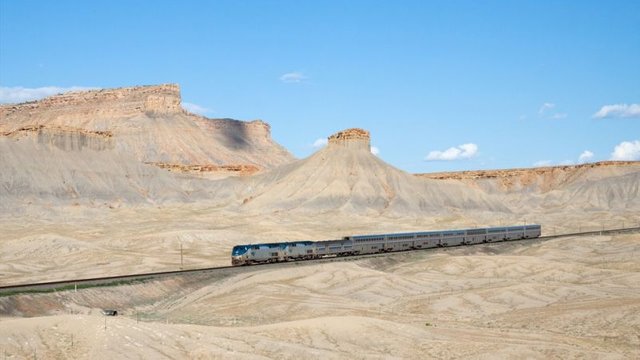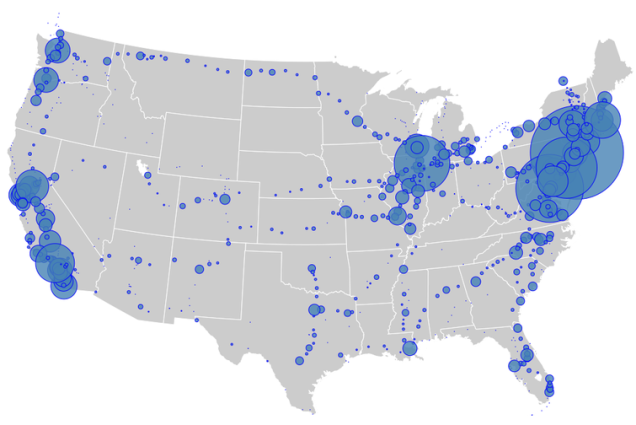Why US trains are slow and expensive as compared to Europe
Image: Crazy Steve / Flickr
A train ride from Washington DC to New York costs at least $ 50 and lasts three hours. A similar path in Europe, between Rennes and Paris, costs $ 30 and lasts two hours. Why US trains are so slow and expensive compared to Europe?
For a handful of reasons, Wendoverproductions explains in its latest video.The first is that not all Americans use the trains:
- In the United States, a country of 319 million people, the state intercity passenger rail network operates 300 trips a day.
- In France, a country of 66 million, the network operates homologous 14,000 train journeys a day, of which 800 are high speed.
Part of the problem comes down to convenience. American cities are not so close together as in Europe. Trains are more convenient than the aircraft when populations are 300-500 kilometers, but in America that's only true if you live in the Northeast, on the West Coast or Texas. The other major cities are too dispersed.
In addition, unlike Europe, most US cities are not intended to passable on foot.People have to take some other form of transportation such as a bus or a taxi to reach the railway station and board the train-and the same will happen in the destination city. In this regard, train stations and airports are evenly matched, so many Americans prefer the plane.
There is a detail. Amtrak, the passenger rail network in the US, is a company subsidized by the government, but designed for profit. In SNCF, the French National Railways, all fares are 50% subsidized by taxpayers.
Picture: freep.com
This explains the price difference between Europe and the United States, what about the slowness? Not only are there very few high-speed trains in the United States: there are often late. On average, only 72% of Amtrak trips are punctual. It gets worse on route from Chicago to San Francisco in June 2016, only 31% of trains arrived on time.
This has to do with freight trains and ownership of the rail network. Amtrak has only 1,200 kilometers of track from 34,300 kilometers in which it operates.The rest of the distributed network companies like Union Pacific and BNSF, which give priority to its freight trains (the Amtrak have to wait for these pass to resume the march).
In Europe, this problem does not exist. In the case of Spain, ADIF manages the entire rail network, which is mainly used by Renfe (the only operator of passenger). The same is true in France, so that you can give priority to passenger trains. But also in Europe only 8% of the goods transported by train, compared with 38% in the US. European roads are less congested than Americans.
Cities with more train users in the United States. Image: Vox
As for the high - speed train, the AVE model Spanish or French TGV is difficult to adapt in the United States, if not impossible. The perfect place to build a line of this type is the Northeast Corridor which connects cities like Washington DC, Philadelphia, New York and Boston.
Paradoxically, are areas where the railroad had so great in the nineteenth century that today are densely populated and have no impact open space between them. It is estimated that building a high - speed network between Washington DC and Boston would involve an investment of $ 151 billion, a figure that settles the debate.



The UK also has a poor record on trains (ironic as we invented and developed them). Part of the problem in the UK is that the network is so old its not laid out for high speed services, so to achieve this we need all new track. The UK is finally creating new infrastructure like the new Crossrail line that will connect suburbs and towns east of London with those in the west of London with a service to Heathrow airport. However this has been needed since the 1970s and was proposed even earlier. High speed inter-city is beginning with HS2, but the fate of this is unsure as the price tag keeps going up.
If we take a step back for a moment though, look at whats happening in transportation; self driving cars. I cant fathom why self driving trains are not already in place.
Great! i believe the Victoria line in London has automation already
Well that was a very insightful article on trains... I didn't think I would ever know that much about the differences in the train systems.
thanks for viewing this article
Informative. In the US, trains are primarily used for freight, which does not require high speed. Therefore the infrastructure does not need to be upgraded for most usages. Passenger lines tend to be subsidized by the government because of infrequent use. The root is Americans like the freedom of cars. Come and go as you please, with privacy, and room to carry all the things you want to buy. It fits our lifestyle. So trains will always be a distant mode of transportation as long as the behaviors remain.
thank you for this info, you have explained the US side well :)
Um very informative cheers
thank you
Wow. This is one of the first articles on trains I have read that actually does justice to the subject! US population density, necessity of owning a car, cost of running freight all work together to make US train travel inefficient. Rail lines typically make money from moving freight across the country and get very little revenue-and lot of complaints- from passenger service. As a result they decided it made more sense to cancel passenger service and focus on freight. People's time is more valuable in America, verses costs of fuel for cars and planes. Planes are just that much faster and more comfortable. Greyhound, effectively can get you to any cities as well, although people would rather travel on their own schedule (drive) than wait for a bus. Busses also have the deserved reputation of having a poor and scruffy passengers.
I think Americans like airplane and personal car.
Besides, US city structure is based on ill - judged urban sprawl with car road.
This is why the train was not developed in the most of the cities in US.